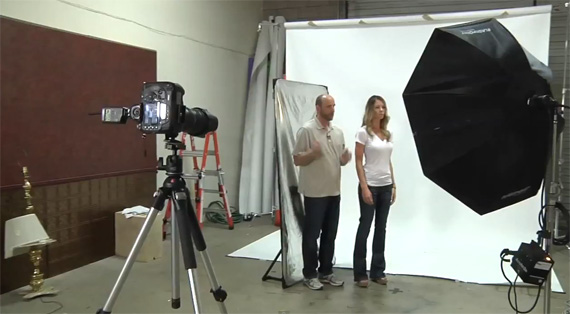 |
Posted: 02 Mar 2012 10:06 PM PST Have you ever wondered how professional photographers are able to take panoramic pictures with ease? Have you ever wished that you had the skills or talents that these photographers have? Have you also wished that you had the extra dough to spend on the next best photography equipment that these photographers are using? If you answered yes to any of the above questions, you are in for a real treat, as I will reveal to you 6 easy steps that you can follow to take panoramic pictures yourself. You will be shocked at how easy this is. You DO NOT need any special skills or talents. You DO NOT need any expensive photography equipment to begin. All you need is a persistent to learn and perfect. You will also need a point and shoot digital camera with manual mode. You do not need any expensive SLR camera to do the trick. Step 1Get your camera and find a nice spot overlooking the entire view of the scene where you wish to take your panoramic picture. Make sure that this spot has a clear unobstructed view of the scene with few subject movements. This means that there should not be too many subjects moving around in the scene as this can cause alignment issues when you are stitching your pictures (more on this in step 6).Step 2Activate your camera grid in the viewfinder (if you are using a SLR camera) or LCD screen display. By activating your camera grid, you will be able to see grids of lines running horizontally and vertically across your camera’s viewfinder or LCD screen display. You can use the camera grid to align against a specific landmark in the scene (e.g. the horizon) so that pictures taken will not be swayed drastically. It helps you to judge the alignment of the scene so that the alignment remains consistent across the series of pictures you will be taking for your panoramic picture.Tip: If your camera does not have the camera grid functionality, you can always make them yourself. How? Get a piece of transparent paper you can find in your local stationery store. Cut out a section that matches your LCD screen display’s size. Draw two horizontal lines and two vertical lines across the cut out section using a pen. Ensure that the four lines are equally spaced. A ruler here would be handy. Once done, just paste it on to the back of your LCD screen display using scotch tape. You now have your own self-made camera grid. Step 3Start aiming your camera at the far right or far left of the scene, whichever you see fit. Set your exposure mode to manual and adjust your aperture and shutter speed according to your environment. The reason for this is to ensure that our pictures have constant exposure, which is important when you take panoramic pictures. Remember to keep your arm squeezed comfortably against your body to maintain maximum stability.Step 4Start shooting away. Take the first picture of the scene and then pivot your upper body slightly to the left or right, depending on where your camera’s position is. If it is at the far right, pivot your body slightly to the left and vice versa. While pivoting, maintain your arm against your body and your hand should try to hold your camera as still as possible. Remember to make use of the camera grid as highlighted in step 2. Take the second picture, making sure that it overlaps the first picture by about 20%. Continue taking pictures in this manner until you reach the other end of the scene you wish to take.Step 5Preview your pictures that you had taken. Check that the pictures are aligned properly as you go over them. You can use the horizon as a guidance. You do not have to be perfect. A slight misalignment between the pictures is okay as it will not be noticeable after stitching.Step 6Use a graphics editing software (I use Adobe Photoshop CS 4) that comes with auto stitching tool. Most graphic editing software can automate the stitching and you do not need to do it manually. For users of Adobe Photoshop CS 4, use the “Photomerge” tool to stitch your pictures magically. Once your pictures are stitched, crop out unwanted areas.There you have it! Being able to take panoramic pictures is not as difficult as it seems to be. Give it a try, and you will be amazed at how easy this is. About the Author: Roy Lee is a freelance photographer residing in Malaysia, who specializes in wedding, portrait, and landscape photography. © Copyright – Roy Lee. All Rights Reserved. For Further Training on Panoramic Photography, PictureCorrect Suggests:Check out The Perfect Panorama; a detailed eBook that walks you through the whole process of how to capture and stitch panoramic photos. This can be accomplished with any ordinary digital camera even if you have no experience with panorama software using this step-by-step guide.It can be found here: The Perfect Panorama Go to full article: How to Take Panoramic Pictures What are your thoughts on this article? Join the discussion on Facebook or Google+ Article from: PictureCorrect Photography Tips |
Posted: 02 Mar 2012 03:58 PM PST As a photographer, it is fairly common to work with models on a variety of photoshoots. Whether it be for a fashion spread or advertisement spot, learning how to hire and work with a photographer is often overlooked. Here is a video tutorial that highlights key points of working with talent on shoots. You can review the clip here: In the video, host Mark Wallace, gives detailed points on conducting a photoshoot which utilizes talent from the moment the model arrives right up to the time they leave. Here are some of the important points made in the video:  Working with Models
For Further Training on Model Poses:Check out this popular guide on how to produce professional portraits by mastering the secrets of camera-friendly poses. It can be found here: Photography Posing SecretsGo to full article: Tips For Working With Models in Photography What are your thoughts on this article? Join the discussion on Facebook or Google+ Article from: PictureCorrect Photography Tips |
Tags:
Photography Learning






0 comments:
Post a Comment